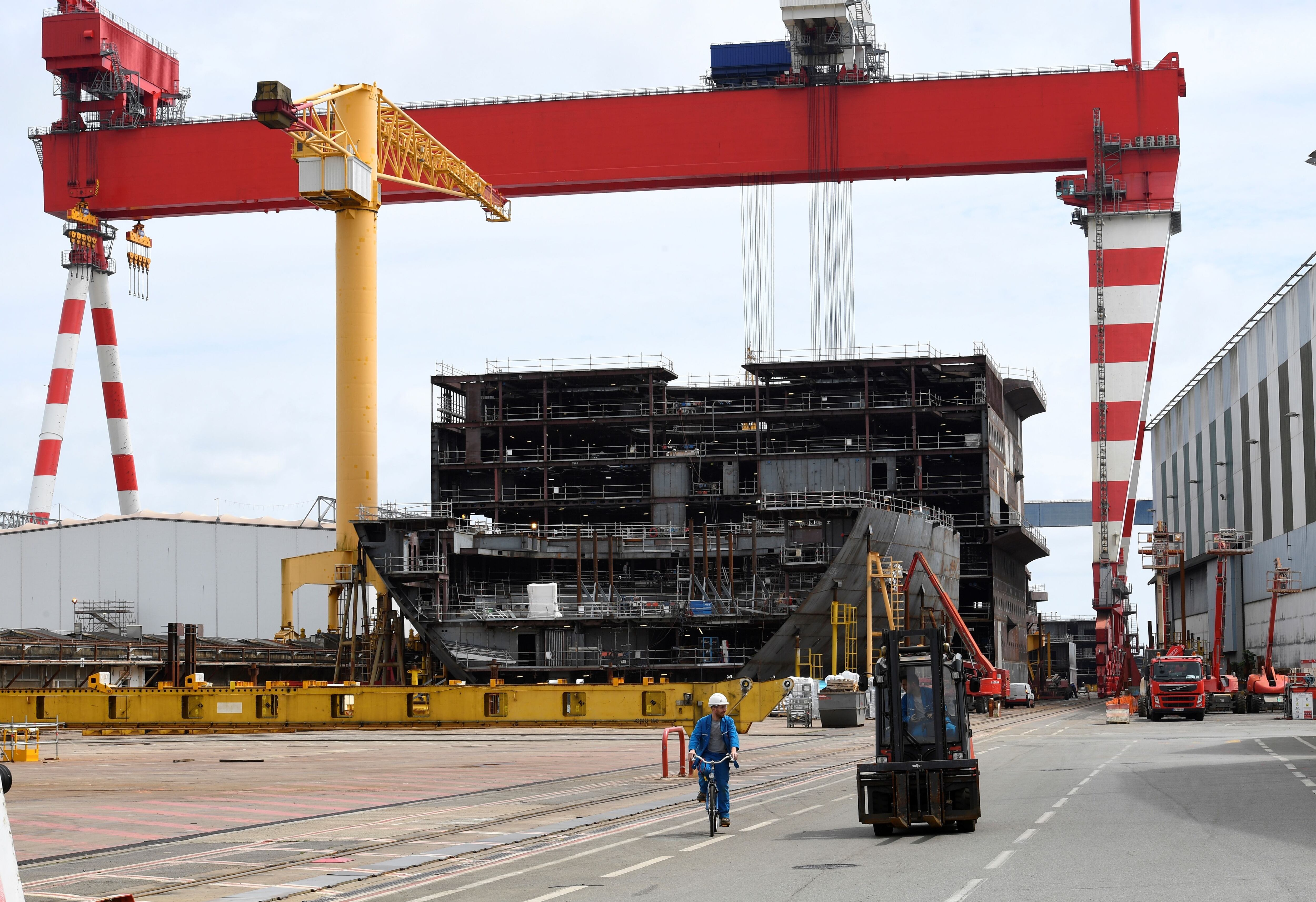PARIS and ROME — A detailed study is quietly being undertaken on the architecture of a concept Franco-Italian anti-missile frigate, and exploring the idea of a European combat management system, according to a French defense source.
“The idea is to have a European Aegis combat management system,” said the source, who spoke on condition of anonymity. OCCAR “suggested” such a study be done, the source said, referring to the European procurement agency.
French Economy and Finance Minister Bruno Le Maire said Sept. 11 on Twitter that there had been a “constructive meeting” with his Italian counterparts, seeking to reach an agreement on the ownership of STX France, a commercial shipbuilder at Saint-Nazaire, western France.
That study for an anti-missile warship is running silently while Paris and Rome seek to defuse a dispute over STX. Working together on warships would be a key element in cooperation sought for the two nations’ naval and commercial shipbuilding industries.
The “fairly discreet” study would set out the warship’s architecture and be delivered by 2019 after three years of work, the source said. The anti-missile weapon would be the long-range Aster Block 1 NT missile, and Leonardo would also work on the system.
The vessel would be the next step on from the Franco-Italian Horizon air-defense frigate and a French variant of the FREMM multimission frigate for air defense, dubbed European air defense frigate, or FREDA.
RELATED

Naval Group is keen to go ahead with the concept ship, which would be built with Fincantieri, but there is tension between subcontractors, with competition between Thales and Leonardo for the radar, the source said.
“Such problems could be solved at the political level,” the source noted.

Thales holds 35 percent of Naval Group, with the French government owning 62.5 percent.
MBDA, Naval Group and Thales declined comment.
The radar would be a key factor in ballistic missile defense as the shipborne system would detect, track and target the incoming missile in the ascent, cruise and descent stages, a naval specialist said. Extending the “radar fidelity” would call for more power, so a higher performing radar would need larger power generation and cooling systems, leading to a heavier warship.
In the search for general cooperation with Fincantieri, Naval Group would look for joint development of the next warships, joint purchase of equipment and an agreement on joint export bids in foreign markets, according to a second naval specialist.
There is increased competition, with offers from shipbuilders in China, Russia and South Korea, which offer not just lower prices but also high-tech options.
Fincantieri and Naval Group have been in talks over the last couple of years about working together on exports, said François Géré, chairman of the think tank Institut Français d’Analyse Stratégique.
“There is need for mutual support and to stop the rivalry, which brings in little of use,” he said. “Italy and France have worked well with together — the Italians have been more flexible, more cooperative than the Germans.”
The two firms have given cooperation talks a code name — Magellano — and Fincantieri CEO Giuseppe Bono and Naval Group CEO Hervé Guillou are known to enjoy a good relationship.
“It is an opportunity not to be missed,” said François Lureau of EuroFLConsult, who once headed the French procurement office Direction Générale de l’Armement. “An agreement is entirely possible, but it is not easy, and great care is needed.”
Naval Group pitched a last-minute offer in 2016 to Qatar, which went on to pick a rival package of four corvettes and a supply vessel from Fincantieri and Leonardo.
A naval cooperation would echo such a drive in land weapons. Nexter and Krauss-Maffei Wegmann have formed a 50-50 joint venture with its headquarters in the Netherland’s capital of Amsterdam.
France temporarily nationalized STX to block a claim for 51 percent ownership by Fincantieri, and Paris and Rome have pledged to resolve that dispute in time for the Sept. 27 summit. That high-level bilateral meeting will discuss industrial cooperation in naval and commercial ships as well as work on future warships.
RELATED

In Rome, an Italian analyst suggested that a naval tie-up could be run along the lines of MBDA, the European missile house in which Airbus, BAE Systems and Leonardo hold stakes. The challenge for Italian and French negotiators is the difference in size between Fincantieri’s naval work and that of Naval Group.
The state-controlled Italian yard sees annual naval turnover of about €1.1 billion (U.S. $ 1.3 billion), a quarter of its €4.4 billion turnover, which derives heavily from cruise ship construction. Of that naval turnover, 49 percent derives from Italian orders, and 43 percent from Fincantieri’s work in the United States, which includes building littoral combat ships with Lockheed Martin, at the Marinette Marine yard it owns in the U.S.
By contrast, Naval Group, which is almost wholly devoted to military work, saw sales of €3.2 billion last year.
The Italian analyst, who spoke on condition of anonymity, suggested that the Italian government might beef up Fincantieri’s size before a tie-up by handing it torpedo activity, formerly known as WASS, which is managed by Italy’s Leonardo.
On the civil side, Fincantieri’s civil work, which amounts to €3.3 billion in turnover, dwarfs STX’s turnover of about €1.4 billion.
That has prompted Italian media to speculate that two Franco-Italian tie-ups might emerge — a civil entity under Italian control and a naval entity under French control. That would be similar to two space joint ventures run by Thales and Leonardo.
The French company leads the satellite joint venture while Leonardo controls the satellite services joint venture. The Italian analyst said that apart from new platforms, a naval joint venture might look at upgrading the Horizon frigates that Italy and France built together.
An Italian industrial source said the focus would likely be on ships built for export, starting with a candidate to become the next frigate for the U.S. In July, the U.S. issued a request for information for a new frigate it wants to be based on existing designs to quickly get it into service.
Fincanteri responded to the RFI, proposing a vessel based on the FREMM design. The yard would happily build FREMM-based vessels for the U.S. Navy at its Marinette Marine yard following the trimming of the LCS order.
There has been a patchy record in naval industrial cooperation. But additional options for Franco-Italian collaboration include a new logistics vessel for France, according to the analyst. Fincantieri is already due to build such a ship for the Italian Navy.
“We could also do a new class of medium patrol vessels, about 3,000 to 3,500 tons, which Italy could use for Mediterranean patrol work and anti-piracy missions,” the analyst said.
The commonality of equipment on the French and Italian versions of the FREMM fell sharply compared to the Horizon, although the two countries worked together designing the two warships. The navies shared on the Horizon a common combat management system — a high-value element — while each country fitted its own combat managment system on the FREMM.
France’s Naval Group and Italy’s Fincantieri waged a legal dispute on the F21 Artemis heavy torpedo, with the International Chamber of Commerce ruling in 2014 in favor of the French shipbuilder, which feared an attempt by its Italian partner to grab control of the program.
The Aster Block 1 NT missile is due for delivery in 2023 and is intended to hit incoming missiles that can maneuver and have a range of 1,300 kilometers.
OCCAR is program manager for the Horizon and FREMM warships, in service with the French and Italian Navies.
Tom Kington is the Italy correspondent for Defense News.








